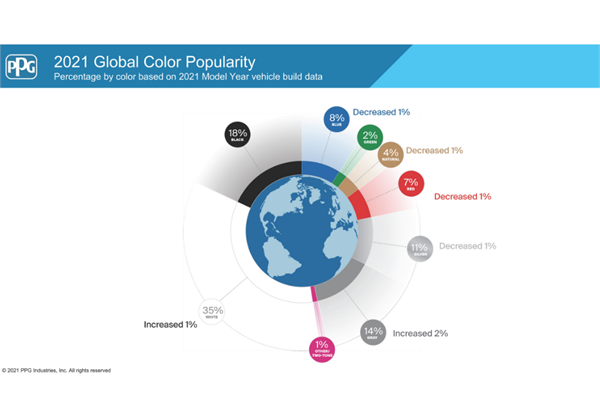
PPG's 2021 Automotive Colour Popularity Report highlights the increased demand for two-tone finishes, custom colours and other emerging trends among car buyers.
PPG has released its 2021 Automotive Colour Popularity Report, which includes emerging trends among car buyers taking into account societal change, holistic colour style and sustainable application technologies. Among these, the main trends concern the increase in demand for two-tone finishes and personalized colours.
The demand for two-tone finishes increases
The rise of two-tone finishes reflects consumers' desire for personalization. Although such finishes were common in the 1950s and 1960s, conventional colour development and application processes made them increasingly impractical due to laborious masking of the vehicle body and numerous runs through the paint shop.
PPG has helped OEMs overcome this challenge through revolutionary application technology that produces crisp paint edges without the use of masking and reducing the time of the coating process. It supports customers' sustainability goals by reducing CO2 emissions and eliminating the need for energy-intensive air filtration systems to manage overspray.
Colour customization is also enabled through PPG advances in digital colour style, which reduces time-to-market for new colours.
“It’s fitting that two-tone finishes would come back into favour during this time when we as a society are looking to the past,” said Misty Yeomans, PPG colour styling manager, automotive OEM, Americas. “Along with special-order colours, tinted clearcoats, tri-coats and matte finishes, two-tone finishes better reflect vehicle owners’ individual preferences and personalities.”
The most popular colours
White (35% of vehicle builds) and black (18%) continue to be the predominant choices of car buyers, while the demand for greys increases by 2% in each of the last two years. Blues remain strong at 8%, while reds drop to 7%.
The popularity of grays, blues, greens and purples is also growing, with new vibrant colours being more likely to be applied to sporty models rather than SUVs and pickups.
Green, with its connection with nature, sustainability and inclusiveness, consolidates its presence all over the world. “Green is also seen as a ’traffic light’ colour, acting as a signal for everyone to go forward – it's safe and we can trust this colour,” Yeomans said. “Green has two directions. One is sporty, fresh and vivid. The other is organic and darker, with deeper tones developed or designed as dark luxury greens yet still with a sporty and fresh attitude.”
“We consider all surfaces and features of the vehicle as part of our colour styling process,” said Yeomans. “As one example, we’re seeing increased use of specialized wheel coatings and colours to complement the styling cues of the vehicle body.”